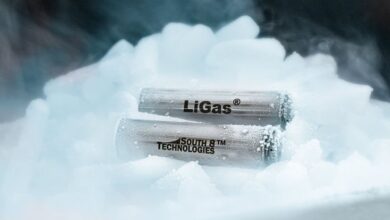Lightning Eyes 10-Minute Charging for its Motorbikes

Lightning Motorcycles is already known for record-setting speeds. In 2011, the company’s LS-218 SuperBike set a landspeed record for production electric motorcycles at the Bonneville Salt Flats in Utah, with a 347.55 kilometer-per-hour (215.91 mile-per-hour) average run and a 351 kph (218 mph) peak. That SuperBike topped every internal combustion engine motorcycle en route to a Pikes Peak International Hill Climb win in 2013, on the Colorado gantlet that’s among the world’s highest-profile tech challenges for cars and motorcycles alike.
The Southern California company is looking to speed things up again—this time with record-setting charging stops. Founder Richard Hatfield claims that the company’s Lightning Strike motorcycle can fill its battery from 20 percent to 80 percent in a little over 10 minutes on a Level 3 DC fast charger. That time isn’t much longer than a gasoline fill-up, especially for motorcyclists who don’t mind some stretching and recovery after hours in the saddle.
Faster pit stops could also help unlock sales for electric two-wheelers, which have been slow to catch on due to dawdling charge times and limited riding range. Whereas electric cars have vastly more space for batteries, motorcycle purveyors can only stuff so many cells into a slender frame before a bike becomes impractically heavy, cumbersome to ride, or ungainly in appearance.
Lightning Motorcycles claims that the Lightning Strike motorcycle can fill its battery from 20 percent to 80 percent in a little over 10 minutes on a Level 3 DC fast charger. Lightning Motorcycles
“Costs are becoming competitive, so the last big issues are range and charge time,” Hatfield says. “For the bikes that don’t have Level 3 charging, it’s a big penalty if you’re trying to ride longer than the battery can take you.”
For the US $13,000 Lightning Strike, zippy charging stops begin with a pouch-format battery from Enevate, with a high concentration of silicon in its anode. That California company claims its silicon-dominant anode material has an impressive specific capacity of about 3,000 milliampere-hours per gram. Lightning Motorcycles integrated the Strike’s 24 kilowatt-hour battery in the same space as 20-kWh pack in its LS-218, for a 20 percent gain in capacity. The result is a curb weight of just under 227 kilograms (500 pounds), about 45 kilos (100 pounds) more than top sport bikes.
The battery pack holds more energy than the 22 kWh pack in BMW’s original i3 electric car that debuted in 2012. Lightning is also developing a 28-kWh pack for its race-oriented LS-218.
Acceleration comparison LMC vs HD
Hatfield says the Strike’s efficient battery delivers a useful real-world range of 150 miles at a 70-mph clip, and closer to 165 or 170 miles in mellower riding. When it’s time to stop, the Strike can absorb Level 3 juice at up to 120 kilowatts. The company posted a YouTube video pitting its bike’s charging time against a Harley-Davidson Live Wire and Zero Motorcycle’s SR/S.
In the video, the Strike adds 12 kWh of power in just under 11 minutes on a typical DC fast charger. That’s closer to a 50 percent recharge than the company’s 60 percent (from 20-to-80 percent) claim. Yet the bike still slurps juice nearly four times faster than the Harley’s 3.3-kilowatt rate, and more than 10 times faster than the Zero, which, like the vast majority of e-motos, is limited to Level 2 AC charging. The Strike’s silicon-anode cells are just one element of the fast pace.
“Every component in between—the cabling, interconnects, even the contactors, had to be reengineered,” Hatfield says.
As with any motorcycle, generating cooling air is no problem when the Lightning is on the move. But managing the intense temperatures generated by DC charging requires a half-dozen fans to move air through the bike’s fairing and migrate heat from components. Software keeps a close eye on thermal metrics during charging, “so we can push harder on a 50-degree morning than a 90-degree afternoon,” Hatfield says. “The cells could charge even faster, but we’re trying to get a balance of system to manage thermal issues.”
The Strike’s electrical architecture operates in the 300-to-400 volt range, depending on the application. But the company is developing an 800-volt architecture for the LS-218, on par with today’s fastest-charging electric cars, such as the Lucid Air, Porsche Taycan or models from the South Korean trio of Genesis, Hyundai, and Kia.
“If we’re doing 300 amps at 400 volts, that’s a (peak) 120-kilowatt charging rate,” Hatfield said. “But 300 amps at 800 volts, and now you’re at 240 kilowatts. That’s really the direction we need to go with this.”
That robust architecture could also generate more sheer force. The standard Strike has up to 132 kilowatts (180 horsepower) and an electric motor that peaks around 7,500 rpm. Boosting voltage, Hatfield said, could push the electric motor closer to 12,500 rpm, generating more than 149 kilowatts (200 horsepower). That figure would top every production ICE motorcycle, including the Aprilia RSV4 Factory’s 140 kilowatts (190 horsepower), as tested by Cycle World.
If there’s any downside, it’s that Lightning, like many other two-wheeled dreamers, hasn’t delivered many motorcycles. Hatfield would not reveal how many bikes the company has made, but said the company can satisfy an order in 90 days.
The company is also aiming to break its own electric speed record, beginning this spring with runs at El Mirage in California, and later at Bonneville—conditions willing on the otherworldly yet shrinking and deteriorating salt surface. The latest target is 402 kph (250 mph), a mind-bending pace on two wheels that requires a special, steely-nerved rider. That rider would be Joe Amo, who has already blown past those speeds on a specially-modified, gasoline-powered Kawasaki. (The Lightning holds the landspeed record for street-legal production motorcycles). But even the world’s fastest internal combustion engine bikes can’t match the Lightning’s tricks, including using a solar-panel array on a mobile van to provide electricity for those record-smashing runs.
IEEE Spectrum




